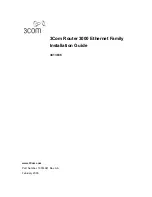
Device Configuration 5 - 79
5.2.6.8 Dynamic Routing (OSPF)
Profile Network Configuration
Open Shortest Path First
(OSPF) is a link-state
interior gateway protocol
(IGP). OSPF routes IP packets within a single routing
domain (autonomous system), like an enterprise LAN. OSPF gathers link state information from neighbor routers and constructs
a network topology. The topology determines the routing table presented to the Internet Layer which makes routing decisions
based solely on the destination IP address found in IP packets.
OSPF detects changes in the topology, like a link failure, and plots a new loop-free routing structure. It computes the shortest
path for each route using a shortest path first algorithm. Link state data is maintained on each router and is periodically updated
on all OSPF member routers.
OSPF uses a route table managed by the link
cost
(external metrics) defined for each routing interface. The cost could be the
distance of a router (round-trip time), link throughput or link availability. Setting a cost value provides a dynamic way to load
balancing traffic between routes of equal cost.
An OSPF network can be subdivided into routing areas to simplify administration and optimize traffic utilization. Areas are
logical groupings of hosts and networks, including routers having interfaces connected to an included network. Each area
maintains a separate link state database whose information may be summarized towards the rest of the network by the
connecting router. Areas are identified by 32-bit IDs, expressed either in decimal, or octet-based dot-decimal notation. Areas
can defined as:
•
stub area
- A stub area is an area which does not receive route advertisements external to the
autonomous system
(AS),
and routing from within the area is based entirely on a default route.
•
totally-stub
- A totally stubby area does not allow summary routes and external routes. A default route is the only way to
route traffic outside of the area. When there’s only one route out of the area, fewer routing decisions are needed, lowering
system resource utilization.
•
non-stub
- A non-stub area imports autonomous system external routes and sends them to other areas. However, it still
cannot receive external routes from other areas.
•
nssa
- NSSA is an extension of a stub that allows the injection of limited external routes into a stub area. If selecting NSSA,
no external routes, except a default route, enter the area.
•
totally nssa
- Totally nssa is an NSSA using 3 and 4 summary routes are not flooded into this type of area. It is also possible
to declare an area both totally stubby and not-so-stubby, which means that the area will receive only the default route from
area 0.0.0.0, but can also contain an
autonomous system boundary router
(ASBR) that accepts external routing information
and injects it into the local area, and from the local area into area 0.0.0.0.
A router running OSPF sends hello packets to discover neighbors and elect a designated router. The hello packet includes link
state information and list of neighbors. OSPF is savvy with layer 2 topologies. If on a
point-to-point
link, OSPF knows it is
sufficient, and the link stays
up
. If on a
broadcast
link, the router waits for election before determining if the link is functional.
To define a dynamic routing configuration:
1. Select the
Configuration
tab from the Web UI.
2. Select
Devices
.
3. Select
System Profile
from the options on left-hand side of the UI.
4. Expand the
Network
menu and select
Dynamic Routing
.
Содержание AP-7131 Series
Страница 1: ...Motorola Solutions WiNG 5 5 ACCESS POINT SYSTEM REFERENCE GUIDE ...
Страница 2: ......
Страница 3: ...MOTOROLA SOLUTIONS WING 5 5 ACCESS POINT SYSTEM REFERENCE GUIDE MN000160A01 Revision A October 2013 ...
Страница 14: ...x WiNG 5 5 Access Point System Reference Guide ...
Страница 22: ...8 WiNG 5 5 Access Point System Reference Guide ...
Страница 26: ...1 4 WiNG 5 5 Access Point System Reference Guide ...
Страница 74: ...3 36 WiNG 5 5 Access Point System Reference Guide ...
Страница 411: ...Device Configuration 5 325 Figure 5 211 Mesh Point Auto Channel Selection Path Method Root Path Metric screen ...
Страница 428: ...6 2 WiNG 5 5 Access Point System Reference Guide Figure 6 1 Configuration Wireless menu ...
Страница 528: ...6 102 WiNG 5 5 Access Point System Reference Guide ...
Страница 610: ...8 40 WiNG 5 5 Access Point System Reference Guide ...
Страница 615: ...Services Configuration 9 5 Figure 9 2 Captive Portal Policy screen Basic Configuration tab ...
Страница 656: ...9 46 WiNG 5 5 Access Point System Reference Guide ...
Страница 670: ...10 14 WiNG 5 5 Access Point System Reference Guide ...
Страница 682: ...11 12 WiNG 5 5 Access Point System Reference Guide ...
Страница 721: ...Operations 12 39 Figure 12 40 Certificate Management Import New Trustpoint screen ...
Страница 738: ...12 56 WiNG 5 5 Access Point System Reference Guide ...
Страница 890: ...A 2 WiNG 5 5 Access Point System Reference Guide ...
Страница 952: ...B 62 WiNG 5 5 Access Point System Reference Guide ...
Страница 953: ......
















































